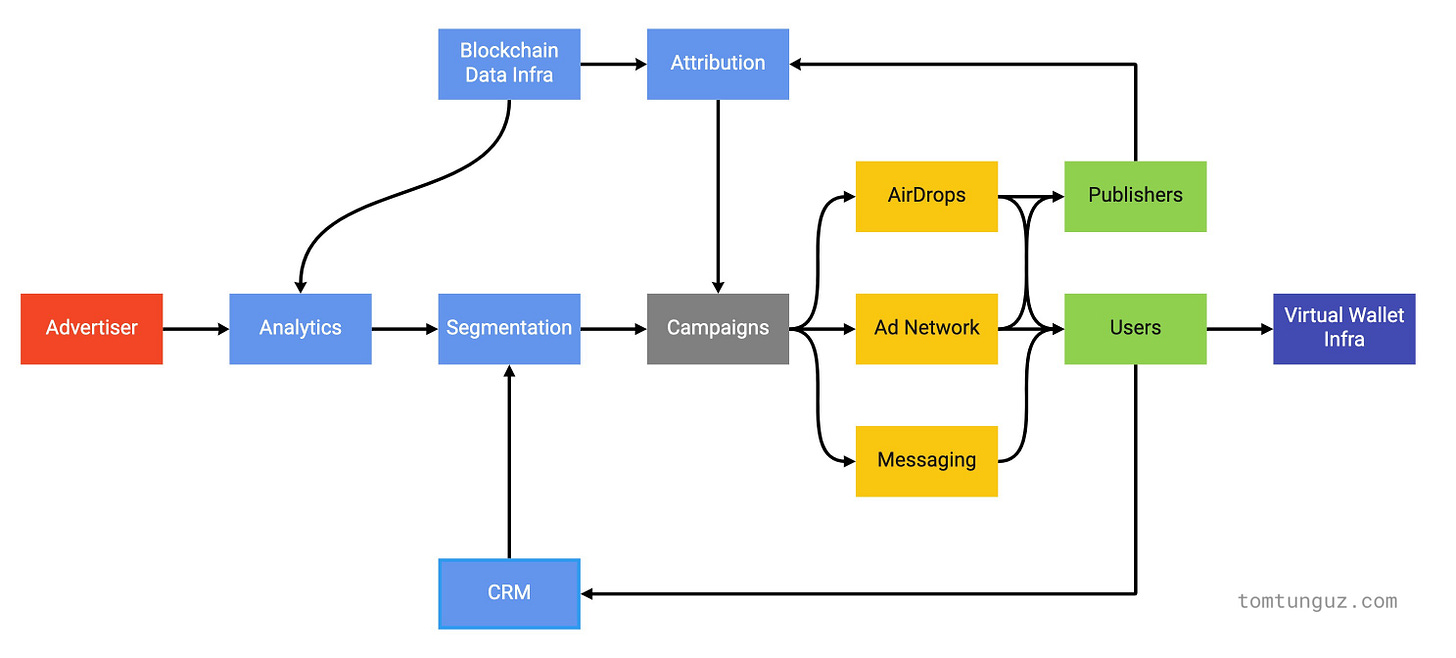The Web 3 Marketing Stack is Happening
Addressable and Spindl are joining forces
Almost exactly a year ago, venture capitalist Tom Tunguz published a prescient blog post where he predicted that the next big development in Web 3 would be the birth and development of a native marketing stack. ‘Stack’ here is being used in the technical sense of vertically-integrated layers of technology that interoperate to create a complex system; the TCP/IP stack that the Internet runs on is a good example.
Topologically though, the interoperating technologies that made web 2 marketing into a billion-dollar machine resembles more of a network of functional boxes. Users and human attention make their way (or are nudged) across this network, being progressively transmuted into revenue and engagement inside products and applications. The learnings from that user voyage—who likes our product? how much does it cost to acquire them? where are they spending time?—are then fed into another turn of the user-acquisition crank, creating a never-ending flywheel that props up the value of trillion-dollar companies like Google and Facebook.

Tunguz’s thesis (and Addressable’s and Spindl’s) is that a similar stack will soon take shape in the blockchain-centric world of Web 3. While the functional boxes might be labeled the same as before (‘attribution’ and ’ad network’) their actual implementation would vary radically from the Web 2 world.
Rather than attribution platforms like Branch or AppsFlyer ingesting or disgorging billions of events a day from countless apps and publishers—an enormously wasteful burden—everyone would use a blockchain as the common reference database. Ads, previously annoying squares of distracting content co-appearing with real content, would assume novel forms like NFT mints, airdropped rewards, app discovery inside wallets, or just the very decentralized chatter of high-follower influencers.
Rather than having Facebook or Google sitting in the middle and extracting much of the value, the decentralized Web and its clever consensus mechanisms will push the value to the edges, to users and creators and independent app developers. The need for creators or developers to attract users never goes away; it only changes into better or worse forms. Web 3 has the ability and incentive to create a vastly more fair, transparent, and open system of user growth than ever existed in Web 21: We aim to build much of that system ourselves.
Today we’re announcing a partnership between two leading Web 3 marketing companies: Addressable and Spindl.
Addressable solves the increasingly urgent ‘publisher problem’ in Web 3, whereby legit protocols and apps have trouble reaching interested audiences of users. The blockchain provides an unprecedented database where both users and builders can share information about each other in an open and permissionless way. But without a way to scalably reach users about new products and protocols, that data can be sliced and diced forever, completely uselessly. Web 3 is full of various ‘CRM’ and ‘analytics’ tools that make for pretty demoware, but are otherwise pretty non-actionable. Addressable changes that, making an audience an actionable segment that builders can reach in a repeatable way. There’s nothing like it in Web 3 today.
Spindl solves the complimentary problem to Addressable: once you bring in users from an Addressable campaign (or any online channel), how well are they monetizing and how long are they sticking around? Also, where’d they come from? Already, Web 3 is a multi-channel world where developers run a Twitter thread alongside a Discord campaign alongside a referral program. How do you figure out which is contributing to new user growth and/or existing user engagement? The technology that decides all that is called ‘attribution’ and Spindl has about the only functional version of it in Web 3. We also have the only referral and user rewards product that runs on complex user incentives like staking for set time periods, buying and holding NFTs, or really any goal you can think of.
Both companies will still be run and staffed independently: this is a product merger not a corporate one. If advertisers want to use Addressable’s audience segmentation and ads-buying tools without on-chain attribution from Spindl, they’re absolutely free to do so. Likewise, builders who want on-chain measurement and rewards without the audience and ads part, you can use Spindl as it is today.
Together though, the combined Addressable/Spindl product will be the first truly usable user-acquisition platform in Web 3: create your audience, find them online, measure their performance, and reward them natively on-chain….all in one unified experience. There’s nothing like this in Web 3 right now, and while we’re the first functional boxes coming together on that Tunguz map, both Addressable and Spindl hope the marketing stack develops even faster and further this coming year. Web 3 won’t succeed without it.
Follow Addressable here, and Spindl here.
For more on Web 3 marketing and attribution, please follow along:
Worth noting, unlike in Web 2, in Web 3 users have complete control of their data via wallets they themselves control. They can participate and flag their interest and participation in games and communities via things like on-chain transactions or NFTs. While some legacy artifacts from Web 2 are still hanging around, we welcome more and more of the marketing stack moving natively on-chain. Cookies and device IDs are already dying on Web 2, and good riddance to all that.





